The following was written by Chris.
The annual ANA World’s Fair of Money was held last week in Rosemont, Illinois. In attendance from Northeast was Frank, Brian, Russell (Tom’s son who sometimes works shows with us), and me. Tom was unable to make the trip, the first ANA he missed after 52 straight years! See his blog post from earlier this month to learn why.
We flew to O’Hare Sunday evening. Our flight was delayed by two hours, though I think weather had something to do with it. For once it was not JetBlue’s fault! Business for us started Monday morning at Dealer Day. I got an early shot looking at coins at a few of my regular wholesalers. Sadly, I didn’t get to look as early as I would have liked, since apparently some dealers flew in Saturday to do business on Sunday. These shows just keep getting longer and longer!
We were all very busy at the show. One long-time coin friend of mine was just across the aisle from me, and I didn’t realize this until three days in to the show! She said I had my head down pretty much the entire time, and she was right. If I wasn’t looking through boxes to buy coins, I was pricing out coins that other dealers had pulled from our inventory.
Brian tried a somewhat different approach to sales at this show, and it seemed to pay off. We had a pretty strong selling show, which is great. Buying was just so-so. Frank and I each bought around two and a half double row boxes of coins. For large shows like this, I usually buy closer to four boxes. We still managed to come home with some cool coins.
Most of our meals were at Gibson’s restaurant, which is a very nice steak place. It’s right across the street from the convention center, so we did takeout from there. We often skip lunch at shows, so it was a nice treat to be able to eat every day!
Brian flew home a day early for family obligations. I stayed until around noon on Saturday, and Frank and Russell wrapped up the show and flew home Saturday night. My flight home was ON TIME. Of course, I was flying Delta for the return trip, so that’s why the plane left when it was supposed to.
For fun on Friday night, Russell, Frank, and I went bowling. We had a great time. I got my @ss handed to me every single game by both Russell and Frank. I’ll get em back next year!
I only got 5 coins (including 4x brand new 25c from the US-Mint vending machine)
And a fine time was had by all.
The following was written by Tom.
We have been busy in the office in recent days getting ready for this important annual convention. Preparing inventory, making arrangements to meet with clients looking to buy or sell, contacting dealers to view inventory early in the show as well as making arrangements for social engagements in the evenings. Never to be missed it has been 52 straight years that i personally have attended. Fresh out of business college in 1972 I still recall the New Orleans show, Boston the following year, & in the subsequent years to Los Angeles, Seattle, New York City & elsewhere around the country.
This year Northeast will be well represented with Chris Clements, Brian Alty, Frank Sawin, & Russell Caldwell in attendance. I however will be taking a break. I am preparing to have open heart surgery soon & air travel has been advised against by my doctors. Yes, the show camaraderie will be missed but Chris, Brian, Frank & Russell will be there to serve you. If you are at the show hope you stop by table 604 /606 to visit. You can also contact me anytime at tom@northeastcoin.com
Tom, what annual convention, and wishing you all the best as you face open heart surgery.
The ANA World's Fair of Money. And thank you for the well wishes, David!
Wishing you the best Tom. Godspeed.
Thanks very much, Dave!
Wishing you nothing but a positive outcome and better health. Here's to a speedy recovery. Remember that every day of post operative recovery is one more day of getting better.
Thanks so much!
The following was written by Helen (Chris' daughter). She is off to Elon University in the fall.
There are two questions a child is typically asked by an adult. The first is “what do your parents do?” I always loved watching adults' faces grow in confusion, and surprise, that a young child just used a big word like numismatist, a word that they didn’t even know. I would then go on to brag about how cool and unique of a job it is and how smart my daddy is. The second question would always be “what do you want to do when you grow up?” Now this question was always answered with a little more hesitation than the first; I look back now as a senior in high school bound for college and realize just how much influence my dad has had on the answer to this question.
Let’s begin by pondering what it is about being a numismatist that singles them out as a very special breed of people. Having grown up with one as my dad, I feel like I can bring an interesting approach to this discussion. For starters, if you are a numismatist you have to be very dedicated to the job. My dad is usually home at 7:00pm, but if I don’t see him, I never need to ask to know that he is still at the office working with coins. Secondly, they’re geeks. And I mean this in the kindest way possible! When my dad gets home from work, I always ask him how his day was and he tends to respond lengthily about either the goings on at the office or about a particularly exciting coin he either bought or sold. He loves to tell me all about the different coins he saw that day or the coins in his own personal collection. In fact, when I was a kid, he used to bring coins home from the large treasure box of mostly worthless but cool coins that they keep in their conference room for kids to grab for free. Thanks to this, at the age of ten I had a very impressive bag of collectables. Despite all his efforts, I never really got into numismatics, although I definitely developed an appreciation for it as I grew up hearing him geek out over his many findings.
The other thing to remember about numismatists is that they travel a lot, so they begin to develop professional critiquing skills about various airlines. I’m sure y’all have seen or heard the rants my dad has gone on about JetBlue’s inability to function properly. Now, imagine that Every Single Time he flies. And yet he still never switches airlines. In other words, along with being professional travel critics, numismatists are very loyal. Although I suppose I can’t complain too much since most of his traveling would lead to me getting a little something from either the airport or state he visited. I remember he brought home a stuffed alligator from a Florida coin show that I absolutely loved and still have today!
And finally, perhaps the most important thing to know about many numismatists (particularly my dad), is the work ethic many embody. One of my most prominent childhood memories is that of school snow days spent at his office and how this experience influenced me in two major ways. First, because of those days, it became very obvious to me how much my dad loves his job. I would be watching Dora on my iPad and look up to see him completely transfixed on his coins. The bright blinding light, the small magnifying glass, and box of coins nearby. That was the happiest I’d ever seen him next to when he is at home with me and my mom. Second, as I grew older snow days became a reason to put me to work when I came into the office. I would be set to filing grading submissions and invoices for Northeast. This was actually my first paying job. At first, I didn’t entirely understand why he was having me do this but I soon learned that this was to teach me about work ethic. He had spent so many late nights at the office processing coins and doing other numismatic things, and filing seemed like a way for him to teach me why.
Now, going into college, I can finally answer the question of what I want to do when I grow up. The simple answer is, I want to be an elementary school teacher. The long answer is that I want to do something that will make me happy and excited, something that makes me want to put my now strong, work ethic to use. With a major in elementary ed, I’m hoping that I will end up doing something that is as important to me as being a numismatist is to my dad.
A very heartwarming story, surely to make dad proud! good luck at Elon!
Thank you, Dave!
helen this was just lovely. being married to a girl whose dad is a numismatist too (!) it almost brought a tear to my eye.
rachel has always been full of nostalgic stories about working at trade shows and all the characters she met there. It's such a meaningful world for the families that are involved in it ❤️
Thanks for reading, Chris!
The following was written by Mike.
Depending on the quantity of coins you want to sell/trade, packing them up to ship can be a conundrum. For customers looking to upgrade their collection, often that process involves trading a lesser graded piece for a higher one. In doing so, you need to safely send in your coins to us for evaluation.
“I’ve never sent coins in the mail before. How do I go about it?” I’m glad you asked! When sending a single coin, I recommend using a simple padded envelope along with a cardboard coin protector. This same process is suitable for up to approximately 10 coins with varying sized padded envelopes.

Once your coin(s) are securely packaged, seal it up with tape. Be sure to include your contact info inside the box in case the return address gets mangled beyond recognition by the USPS.
When bringing the package to the post office to get postage for your coin(s), the following steps are highly recommended:
- Send your package with “Signature Required.” All packages we ship require a signature if the value is over $300.00. This will help ensure that your package is not left to the wolves.
- Insure your package! Until it reaches us, you are responsible for the package while in transit. This would also apply on the off chance you need to return a coin you bought from us.
So, you say you have over ten coins to ship? The more the merrier! Let’s go over how we would pack these up, as there is a little more to it than in the previous scenario. When shipping a large number of coins, the most important thing to consider is the safety of the coins themselves. With that many in one package, the likely shipping vessel will be a box which introduces a whole other level of risk. First, if not packaged correctly, they will rattle against each other, possibly damaging the coins or holders. Second, while en route people might get curious as to what is inside the package, running the risk of theft.
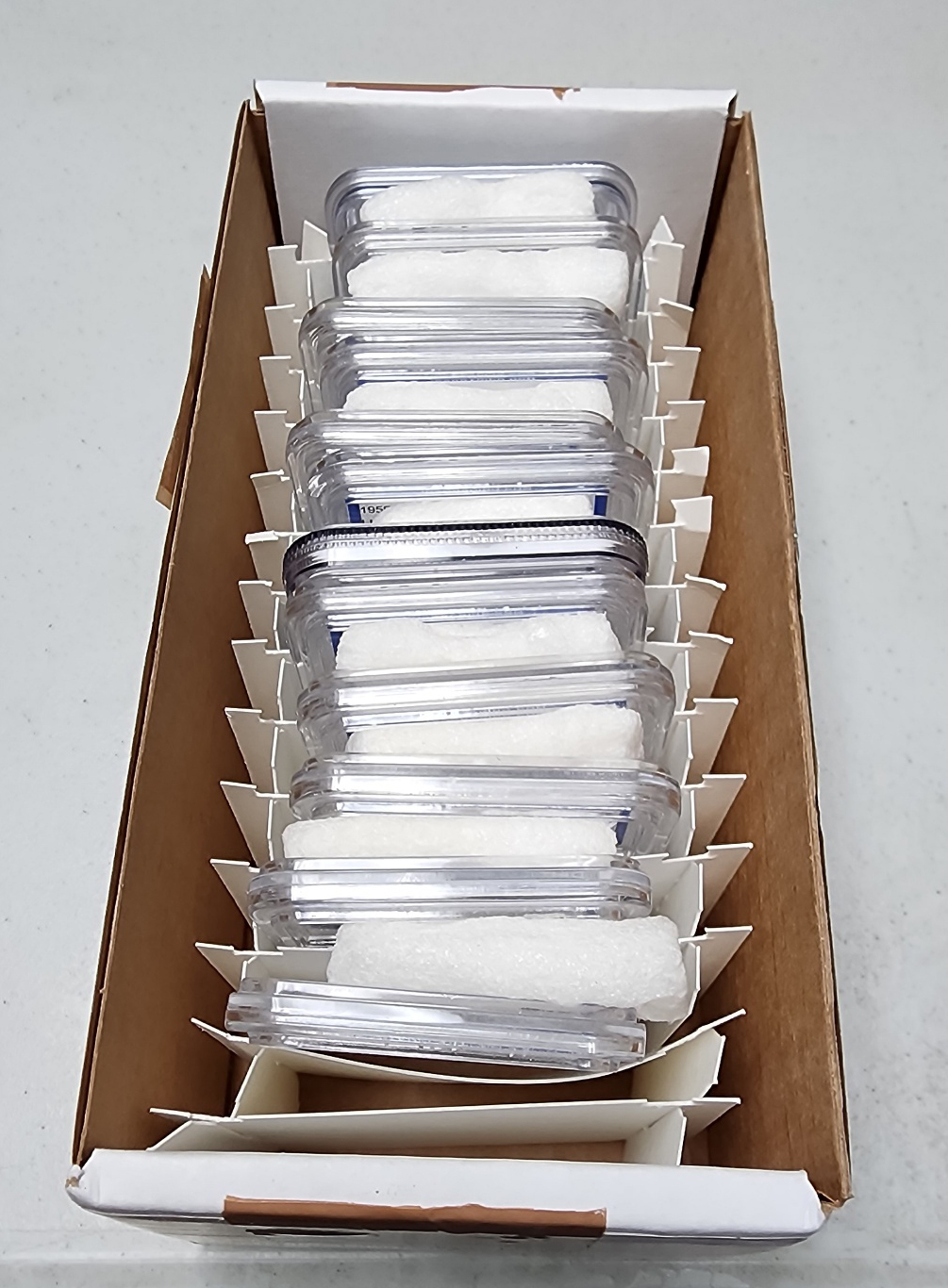
This is how we would recommend packing the coins to prevent rattling inside the box. While the average home collector may not have the same packing material that we have access to, the easiest way to prevent rattling is to simply use a rubber band! Band together 4-5 coins along the width and length; this strategy will stop them from rattling around when packed together in a box.
When we receive packages that are of the larger size, we love to see them packed a certain way. It’s important to remember that when paying for postage and insurance, (large value sale/trade), the following instructions can prevent considerable loss of value if anything happens in transit.
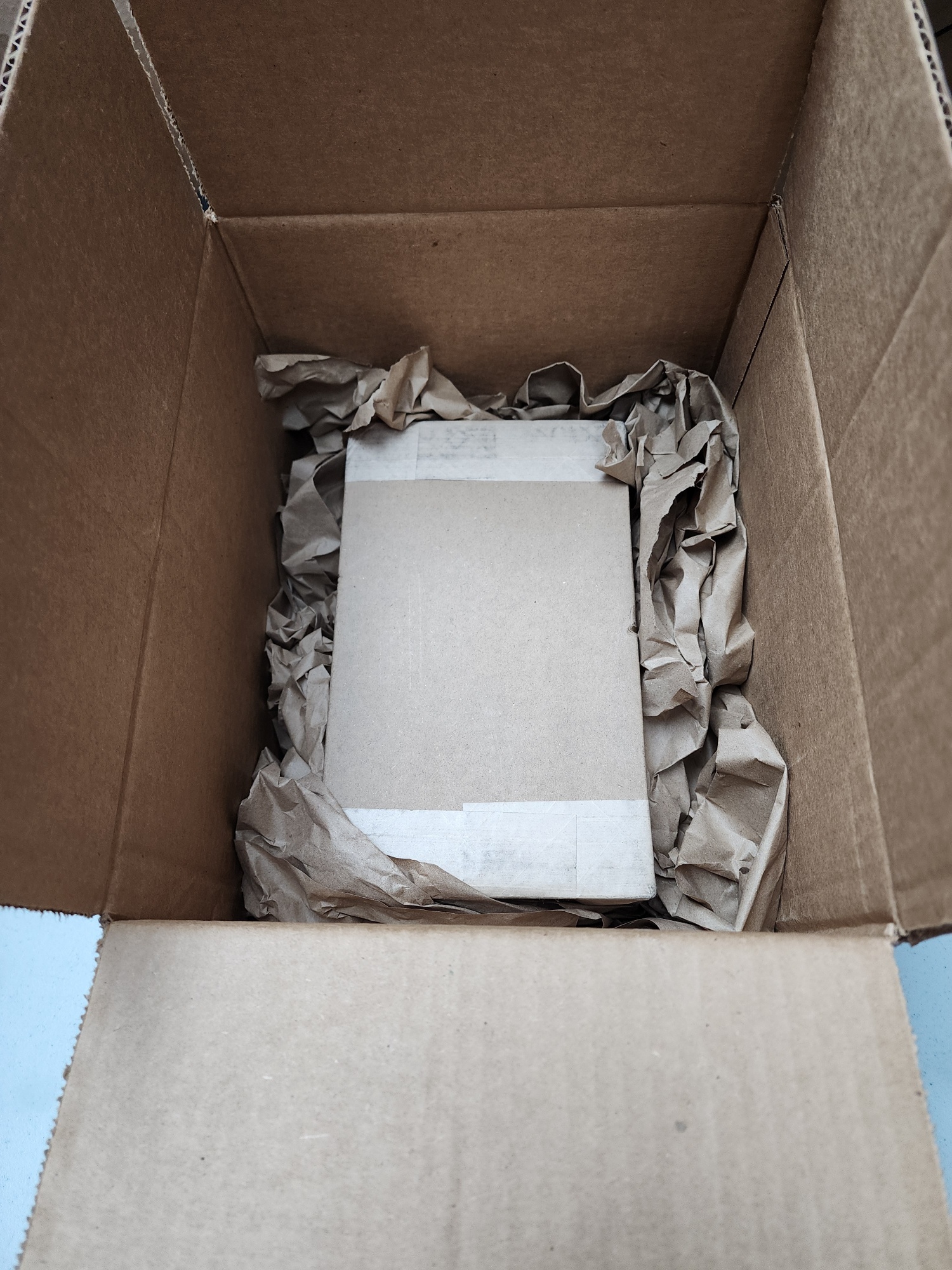
The secret to secure, safe packing is to pack your coins in a smaller box, placing that box into a larger box. There are a few reasons why this strategy is effective:
- When we pay for postage and insurance on the package, our private insurance company requires this. If they have this requirement, it makes sense to follow it even when using USPS insurance.
- If the outside package is damaged in transit, the USPS cannot see the contents inside the smaller package, adding a level of security.
- The double layer of packaging provides additional protection. When placing a small box into a larger box, a significant void space is created. To fill this space, we recommend either bubble wrap or packing paper. Newspaper also works well or anything that will snugly fill the void without adding too much weight. One thing we ask is…no dirty laundry (this has happened before)!
Finally, if you ever have questions regarding the shipping process, feel free to reach out to me anytime at mike@northeastcoin.com. I try to respond as quickly as possible and look forward to helping in any way. I draw the line at flying out and packing everything up for you, unless you pay me. Kidding. Or am I?
Important addendum. You should address the package as follows. Be sure you leave the word Numismatics out of our company name.
Northeast
Attn: Name (You can leave this line out if you're not sending the package to a specific person.)
100 Main Street, Ste. 330
Concord, MA 01742
The following was written by Frank.
Coins have been counterfeited since the days of the Roman Empire and counterfeiters continue to deceive the average everyday consumer and the astute numismatist alike to this day. The U.S. Secret Service estimates that there is $147 million in counterfeit U.S. currency in global circulation. After thousands of years, it is clear that the issue of counterfeiting is here to stay, even though there are high-tech security measures in today’s paper currency. Similarly, counterfeiters have been counterfeiting rare coins with intentions to deceive collectors and dealers. In this blog post, we will be focusing on two of the most common counterfeit coins, the 1909-S VDB Lincoln Cent and the 1916-D Mercury Dime.
The 1909-S VDB Lincoln Cent is one of the most popular coins of the twentieth century. In high uncirculated grades, this coin can be worth many thousands of dollars. It’s no surprise that counterfeiters would want to counterfeit such a popular and valuable coin. Many counterfeit pieces are either genuine 1909 VDB or 1909-S cents with alterations; either the S is added to where the mintmark should be, or the designer’s initials, VDB, are added to where they should be on the reverse. One way to differentiate a genuine example is by the examination of the mintmark and the VDB. There are only 4 mintmark positions on genuine 1909 S VDB cents, so it must match one of the 4 pictured below.
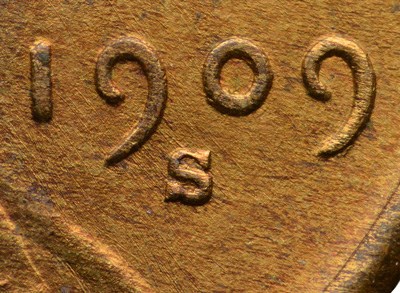
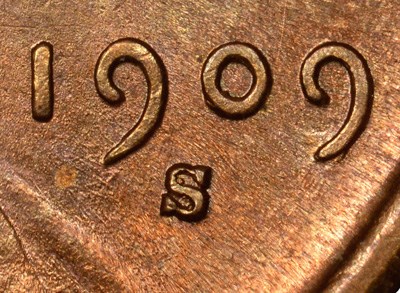
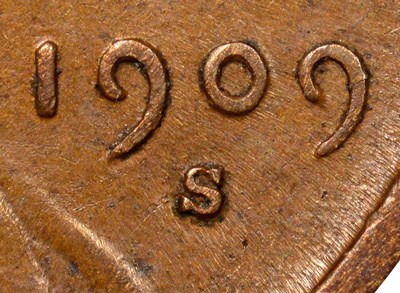
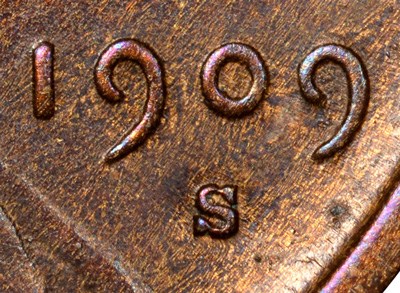
Images courtesy of NGC.
Pictured below are the differences between genuine and counterfeit designer initials. The first one is a counterfeit, the second is genuine.
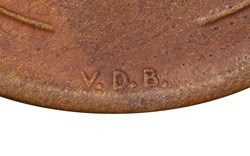
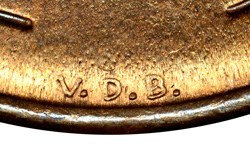
Images courtesy of NGC.
Another popular key date that is often counterfeited is the 1916-D Mercury Dime. Similar to the 1909-S VDB cent, a genuine 1916-D Mercury Dime can be worth many thousands of dollars; counterfeiters focus on popular key date coins. Many counterfeit 1916-D Mercury Dimes are either genuine 1916 Philadelphia or San Francisco issues, but with either an added or altered mintmark. There are 4 known reverse dies that struck 1916-D Mercury Dimes. Interestingly enough, all genuine 1916-D Mercury Dimes have a slightly rotated die. The mintmark on genuine examples also has a triangular shape inside the mintmark.
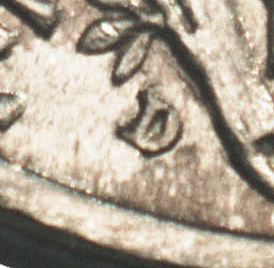
Image courtesy of CoinHelpU.
One of the best ways of detecting counterfeit coins is by handling lots of coins and having sufficient tools. Once you get an understanding of what genuine examples of rare coins look like, you’ll be able to say to yourself “That doesn’t look right.” when encountering counterfeits. It is oftentimes hard to describe why you believe a coin to be counterfeit, but after a while you will certainly get an eye for counterfeit detection. Because of such minute details, a 10 power jewelers loupe is recommended for counterfeit detection.
This article was merely a brush over on the topic of counterfeit coins and can be delved into much deeper. Because counterfeit rare coins are an everlasting threat to the hobby and will only get better, we stress the importance of buying rare coins authenticated and graded by dependable third-party grading services. An emerging threat to the hobby are counterfeit slabs. This will be the topic of the next edition of Frankly Speaking that will be released shortly. Stay tuned!
Sources:
https://coinauctionshelp.com/1916-dmercurydimeID.html
https://www.ngccoin.com/news/article/5217/Counterfeit-1909-S-VDB-Lincoln-Cents/




